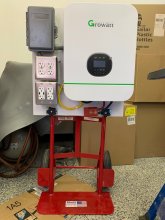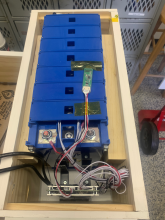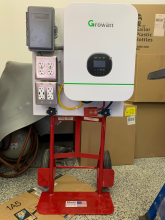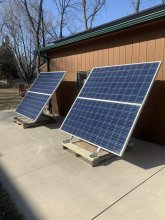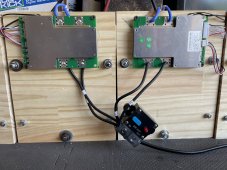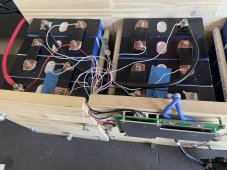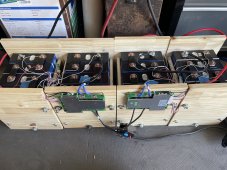I have a Growatt 3000 watt 24 v inverter with 8s - 100ah fortune batteries. This is a mobile solar generator. I am using a 100ah Overkill solar BMS. I have it almost done but I am a little confused on my setting parameters. What would be the settings for 85% charge and 20% low voltage to program into my Growatt. Then what would I set my BMS for for a little higher and a little lower voltages to have another safety range. Thanks in advance.
You are using an out of date browser. It may not display this or other websites correctly.
You should upgrade or use an alternative browser.
You should upgrade or use an alternative browser.
Growatt 24v 8s 100 ah fortune batteries settings
- Thread starter beefitter
- Start date
williamseric1111
New Member
- Joined
- Feb 20, 2021
- Messages
- 9
I am on the same journey with you…. Growatt 24v was just delivered, waiting on 200ah batteries to arrive. I am looking at the Overkill BMS so i will be following your post to see what advice you are given. May I ask a question? I will have 16 Lifepo4 batteries. Planning on paralleling two sets of 8s and each with a 100A (not 100ah as your post says) Overkill BMS, and I am still wondering if that will be enough for this inverter. Isn’t the Growatt 24v a 3000watt inverter with 6000 max? If you are running a 100a BMS at 24v, that’s 2400 watts. Are you concerned you will not have enough? I was concerned with the 4800 watts, not that I planning on hitting that level. I am a complete rookie myself so I am eager to learn. Good luck with your project.
Congratulations at giving this solar project a try. I think you have to realize that all of this power does not come in to the unit at once. The power coming in to the inverter is limited by how much solar actually is coming in. With the VOC of the inverter at 145vdc, you are a little limited on the number of solar panels. I have purchased 4 - REC 310 watt solar panels for $120 each. They are new panels. I will be putting them in 2s2p configuration. I wanted to do six panels but the VOC was too high. If the batteries get fully charged the inverter will go into float mode, so I think I am ok. I also wanted to see how this system performs with the 8 - Fortune batteries, I can always add another 8 for a 16s configuration if needed. My plan was to use this system in my ice fishing house. It can be -20F when fishing out on a lake, at those temperatures the panels will be at the high end of their performance. Plus I wanted portability to easily move the system. I hooked everything up on my Growatt this last weekend. I went to start it up and the unit shut down with error code 81. I emailed Watts247 on Saturday. Ian got back to me a little later. He gave me the fix. The inverter was in parallel mode and needed to be in single mode. I got that fixed, then I got a new error code, 53. Ian got back to me twice on Sunday. After several attempts to reset the inverter, I was still getting that error code. On Monday Ian from Watts247 emailed me after I told him that I still had the error code, he shipped me a new unit. I will have it tomorrow. Watt247 has been very helpful and great customer service, helping me on the weekend and getting me a replacement as fast as it could happen.
You can see in the pic that the unit is mounted on a hand truck. The unit can be removed from the cart and moved by itself and hung on a wall of my ice house. The battery is housed in a beekeeping hive box called a five frame nuc box. It fit perfectly with the BMS on one end. I know I have to see how warm the battery can get in this box. There is ventilation on the bottom. The yellow cord is the utility plug, the red Anderson plug hooks up the battery to the inverter.
You can see in the pic that the unit is mounted on a hand truck. The unit can be removed from the cart and moved by itself and hung on a wall of my ice house. The battery is housed in a beekeeping hive box called a five frame nuc box. It fit perfectly with the BMS on one end. I know I have to see how warm the battery can get in this box. There is ventilation on the bottom. The yellow cord is the utility plug, the red Anderson plug hooks up the battery to the inverter.
Attachments
Terrapin
New Member
Will mentions capacity testing in this post to determine a certain DOD setting... https://diysolarforum.com/threads/r...e-for-diy-lifepo4-batteries-sticky-post.5101/
williamseric1111
New Member
- Joined
- Feb 20, 2021
- Messages
- 9
Thanks for the reply and I love the pics!! Clean work. I also opted for Ian and Watts247, good to hear of your experience. Now I am just hoping I didn't screw up and order the batteries from a poor choice in China. I have another 3 weeks to worry about that. I stumbled on this forum AFTER ordering batteries. :-(Congratulations at giving this solar project a try. I think you have to realize that all of this power does not come in to the unit at once. The power coming in to the inverter is limited by how much solar actually is coming in. With the VOC of the inverter at 145vdc, you are a little limited on the number of solar panels. I have purchased 4 - REC 310 watt solar panels for $120 each. They are new panels. I will be putting them in 2s2p configuration. I wanted to do six panels but the VOC was too high. If the batteries get fully charged the inverter will go into float mode, so I think I am ok. I also wanted to see how this system performs with the 8 - Fortune batteries, I can always add another 8 for a 16s configuration if needed. My plan was to use this system in my ice fishing house. It can be -20F when fishing out on a lake, at those temperatures the panels will be at the high end of their performance. Plus I wanted portability to easily move the system. I hooked everything up on my Growatt this last weekend. I went to start it up and the unit shut down with error code 81. I emailed Watts247 on Saturday. Ian got back to me a little later. He gave me the fix. The inverter was in parallel mode and needed to be in single mode. I got that fixed, then I got a new error code, 53. Ian got back to me twice on Sunday. After several attempts to reset the inverter, I was still getting that error code. On Monday Ian from Watts247 emailed me after I told him that I still had the error code, he shipped me a new unit. I will have it tomorrow. Watt247 has been very helpful and great customer service, helping me on the weekend and getting me a replacement as fast as it could happen.
You can see in the pic that the unit is mounted on a hand truck. The unit can be removed from the cart and moved by itself and hung on a wall of my ice house. The battery is housed in a beekeeping hive box called a five frame nuc box. It fit perfectly with the BMS on one end. I know I have to see how warm the battery can get in this box. There is ventilation on the bottom. The yellow cord is the utility plug, the red Anderson plug hooks up the battery to the inverter.
I didn't completely follow your comments about "power coming in to the inverter is limited by how much solar actually is coming in". Isn't the BMS only in context to the batteries and the power you can get from them to the inverter? Are you referring to the "charger" not the "inverter" Meaning if I put a load on the "inverter" of 3,000watts, a 100a BMS at 24v will pop. It can only handle 2400 watts. No? This is where I was thinking I needed at least 250a, or possibly 2 at 100a which has some redundancy built in.
It's my understanding that if you have 80amps on the charger (or whatever the max solar charge is) coming in off the solar panels charging the batteries AND you are using the inverter to run an appliance simultaneously, you actually have to add both of those numbers together to calculate your needs on the BMS? No?
For my setup, I am thinking 2 100a BMSs. That's 4,800watts sustained.
Either way, press on my friend. I will keep an eye on your project. Good stuff!!!
God bless...
Last edited:
I think you are over thinking this a bit. First if you are using sixteen cells with your battery bank you need one 16S BMS not two 8S BMS (Do not use the 2 - 8S BMS on 16 cells). The numbers you are throwing out there are all maximum scenarios. Like the charger for instance, yes it is rated for 80 amps, but if you are charging with utility, off a home 120v outlet or from a generator, I don't think in this case you can get even near 80 amps off a 20 amp circuit. Charging with solar, you only get to the highest output of the panels between around 10 am and 2 pm. Either side of that time frame the solar panels will be having a lower output.The pic I have attached is my solar production on my home solar from yesterday. 87 kilowatts from 50 - 335 watt solar panels. The pic shows how the solar performs during the day. The whole day was sunny with no clouds. My highest output since Oct. 4th of last year.
My four solar panels for the Growatt put out 8 amps each, so I am not even near the 80 amp limit. With the solar panels, you cannot exceed the total VOC rating of your panels to over 145vdc on the Growatt. On the AC output, I have one 20 amp circuit. I cannot exceed 20 amps on this side of the inverter because of my wire size and breaker.
If your batteries say are in a 50% state of charge, when they start to get charged by the Growatt, they will be charged using bulk mode. This is the highest level charging the batteries get. None of my power sources will put out 80 amps. When the batteries are getting full the Growatt switches to float, then when in a full state of charge the mode is absorption. All of these parameters can be set on the Growatt. I am thinking with my four panels, it will take about 2-1/2 hours to charge my battery on a sunny day during max solar hours 10 am - 2 pm. Longer if I am on either side of that time frame.
The Growatt cannot put out more than 3000 watts. It is rated for that, but in the real world plan on 2600 - 2800 watts. Your big battery set up will get you more storage but it will not increase any output numbers. Your system will be around 4.8 kilowatts of storage. So you could run a 1000 watt load for 4.8 hours. My 2.4 kilowatt battery can run a 1000 watt load for 2.4 hours. These are perfect world scenarios but the actual numbers would be different because we don't want to totally drain the battery. Battery setup which what I was looking for, is to charge the battery to a 85% state of charge on the high end and a 20% state of charge on the low end.
My four solar panels for the Growatt put out 8 amps each, so I am not even near the 80 amp limit. With the solar panels, you cannot exceed the total VOC rating of your panels to over 145vdc on the Growatt. On the AC output, I have one 20 amp circuit. I cannot exceed 20 amps on this side of the inverter because of my wire size and breaker.
If your batteries say are in a 50% state of charge, when they start to get charged by the Growatt, they will be charged using bulk mode. This is the highest level charging the batteries get. None of my power sources will put out 80 amps. When the batteries are getting full the Growatt switches to float, then when in a full state of charge the mode is absorption. All of these parameters can be set on the Growatt. I am thinking with my four panels, it will take about 2-1/2 hours to charge my battery on a sunny day during max solar hours 10 am - 2 pm. Longer if I am on either side of that time frame.
The Growatt cannot put out more than 3000 watts. It is rated for that, but in the real world plan on 2600 - 2800 watts. Your big battery set up will get you more storage but it will not increase any output numbers. Your system will be around 4.8 kilowatts of storage. So you could run a 1000 watt load for 4.8 hours. My 2.4 kilowatt battery can run a 1000 watt load for 2.4 hours. These are perfect world scenarios but the actual numbers would be different because we don't want to totally drain the battery. Battery setup which what I was looking for, is to charge the battery to a 85% state of charge on the high end and a 20% state of charge on the low end.
Attachments
Last edited:
williamseric1111
New Member
- Joined
- Feb 20, 2021
- Messages
- 9
Very very very helpful. Thanks for detailed reply and the time it took to write. I promise it was useful and appreciated. Sounds like my wallet will be happier also. Press on my friend.
Now this bit about the BMS is confusing me. You say that williamseric1111 should use one 16S BMS and not two 8S BMS. This thread discussed a 24V system. 8S will give you 24V and you can put two batteries in parallel (hence 2 BMS) to double your amp/hour. If you use a 16S, wouldn't you get 48V? Please tell me how you would wire the 16S BMS to get 24 VDC?I think you are over thinking this a bit. First if you are using sixteen cells with your battery bank you need one 16S BMS not two 8S BMS (Do not use the 2 - 8S BMS on 16 cells). The numbers you are throwing out there are all maximum scenarios. Like the charger for instance, yes it is rated for 80 amps, but if you are charging with utility, off a home 120v outlet or from a generator, I don't think in this case you can get even near 80 amps off a 20 amp circuit. Charging with solar, you only get to the highest output of the panels between around 10 am and 2 pm. Either side of that time frame the solar panels will be having a lower output.The pic I have attached is my solar production on my home solar from yesterday. 87 kilowatts from 50 - 335 watt solar panels. The pic shows how the solar performs during the day. The whole day was sunny with no clouds. My highest output since Oct. 4th of last year.
My four solar panels for the Growatt put out 8 amps each, so I am not even near the 80 amp limit. With the solar panels, you cannot exceed the total VOC rating of your panels to over 145vdc on the Growatt. On the AC output, I have one 20 amp circuit. I cannot exceed 20 amps on this side of the inverter because of my wire size and breaker.
If your batteries say are in a 50% state of charge, when they start to get charged by the Growatt, they will be charged using bulk mode. This is the highest level charging the batteries get. None of my power sources will put out 80 amps. When the batteries are getting full the Growatt switches to float, then when in a full state of charge the mode is absorption. All of these parameters can be set on the Growatt. I am thinking with my four panels, it will take about 2-1/2 hours to charge my battery on a sunny day during max solar hours 10 am - 2 pm. Longer if I am on either side of that time frame.
The Growatt cannot put out more than 3000 watts. It is rated for that, but in the real world plan on 2600 - 2800 watts. Your big battery set up will get you more storage but it will not increase any output numbers. Your system will be around 4.8 kilowatts of storage. So you could run a 1000 watt load for 4.8 hours. My 2.4 kilowatt battery can run a 1000 watt load for 2.4 hours. These are perfect world scenarios but the actual numbers would be different because we don't want to totally drain the battery. Battery setup which what I was looking for, is to charge the battery to a 85% state of charge on the high end and a 20% state of charge on the low end.
Yes, I think you are correct. My mistake. Check out Will's video on making a battery using multiple batteries in parallel and series to make a bigger battery capacity without increasing voltage.Now this bit about the BMS is confusing me. You say that williamseric1111 should use one 16S BMS and not two 8S BMS. This thread discussed a 24V system. 8S will give you 24V and you can put two batteries in parallel (hence 2 BMS) to double your amp/hour. If you use a 16S, wouldn't you get 48V? Please tell me how you would wire the 16S BMS to get 24 VDC?
Good! Thanks for the correction, now I am with you.
I want to build a system similar to William, with 2 - 24V batteries in parallel, each with their own BMS so all cells are individually monitored and protected. To that I will couple a 2000 watts inverter or inverter/ charger. I don't need a bigger inverter since it is only for an off-grid cabin. Mainly for lighting and water pumps. My biggest criteria is to have an efficient inverter that wastes the least amount of power both ON and in standby mode. Any recommendations out there for efficient inverters that won't cost me my first born?
Thanks in advance.
I want to build a system similar to William, with 2 - 24V batteries in parallel, each with their own BMS so all cells are individually monitored and protected. To that I will couple a 2000 watts inverter or inverter/ charger. I don't need a bigger inverter since it is only for an off-grid cabin. Mainly for lighting and water pumps. My biggest criteria is to have an efficient inverter that wastes the least amount of power both ON and in standby mode. Any recommendations out there for efficient inverters that won't cost me my first born?
Thanks in advance.
For the money, it is hard to beat the Growatt all in one inverters. You can buy more efficient setups, but then you are getting stand alone charge controllers and inverters such as Victron. Victron is efficient and a top notch product but three times the money. You would be better off trying to increase your battery size to compensate for any inefficiencies of a cheaper all in one inverter. I have my 24v Growatt 3000 watt up and running recently. I have four 310 watt solar panels hooked up to the inverter. I am using 8 - 3.2v Fortune batteries. I did see the Gyll 5.2 kw batteries sold by Signature Solar. They look top notch. David Poz did a YouTube video about them.
Here is a couple pics of my growatt on a two wheel cart. I put the battery in a bee hive box with an overkill solar 8S 100AH BMS.
Don't undersize the inverter. Anything running with a motor, usually will have a startup surge. If the inverter can't handle the surge it may shut down. Solar is not perfect to what performance may be in a perfect world. Always oversize your system by 20% to have a more predictable outcome. Plus winter affects performance. I live in Minnesota. I have a 16.5 kw solar grid tied system. In winter, a good month is 500 kw to 700 kw of production, I have had a month as low as 38 kw. This month of March has been great, two more days left in the month and I should be over 2 MW of power.
My Growatt 3000 watt system can only support 145v DC. So when I figured my solar panels, the most I could do is 4 - 310 watt REC panels. When I figured the VOC of the four solar panels, I decided I could not put on anymore solar panels. Having an inverter with a higher DC voltage input could get you more solar panels. Panels are cheap if you look around. Adding more panels also can offset any higher inverter power consumption. Signature solar is selling 310 watt REC panels for $99.00 each. The panels were made in 2016 I think, but they are new panels.
Here is a couple pics of my growatt on a two wheel cart. I put the battery in a bee hive box with an overkill solar 8S 100AH BMS.
Don't undersize the inverter. Anything running with a motor, usually will have a startup surge. If the inverter can't handle the surge it may shut down. Solar is not perfect to what performance may be in a perfect world. Always oversize your system by 20% to have a more predictable outcome. Plus winter affects performance. I live in Minnesota. I have a 16.5 kw solar grid tied system. In winter, a good month is 500 kw to 700 kw of production, I have had a month as low as 38 kw. This month of March has been great, two more days left in the month and I should be over 2 MW of power.
My Growatt 3000 watt system can only support 145v DC. So when I figured my solar panels, the most I could do is 4 - 310 watt REC panels. When I figured the VOC of the four solar panels, I decided I could not put on anymore solar panels. Having an inverter with a higher DC voltage input could get you more solar panels. Panels are cheap if you look around. Adding more panels also can offset any higher inverter power consumption. Signature solar is selling 310 watt REC panels for $99.00 each. The panels were made in 2016 I think, but they are new panels.
Attachments
Thanks a lot for the input. Do you have to use the Growatt built-in charge controller? I have a Schneider Conext 150v/60A MPPT charge controller which is very well built and bullet proof. Could I just use the inverter / charger functions or would it throw the whole thing out of wack? I know it is crazy but when you paid top dollars for an item, it is hard to set it aside for the new shiny toy that does it all. All I need to make my system is a good 24V 2000W inverter / charger. There are lots out there but are they reliable.
I'll keep looking but like you say, for the money, the Growatt is impressive.
I'll keep looking but like you say, for the money, the Growatt is impressive.
If you buy an all in one inverter, that is what you use. Your charge controller is out. Very easy for a new solar user to purchase something, only to find out later that it might not fit their system. After many years in construction, the thing I learned is to never try to build around an existing component. It usually ends up costing you more and causes headaches and grief that can be avoided by doing it right in the first place. You seem to be focused on a 2000 watt inverter. A 3000 watt inverter would give you leeway to make sure your needs are covered. Buying a product that is just big enough, leaves no room for expansion. You never know what your future needs will be. Spending an extra $100 now on a little bigger inverter, would save you a lot, if you needed another bigger inverter down the road.
That is a sound advice! Thanks a lot. It would be cheaper and certainly simpler. I checked the specs on the Growatt and they are good. I live in Ontario but my cabin is in Northern Quebec so I understand when you say that solar has its limitations. We don't all live in Las Vegas like Will, where the sun shines 340 days a year...
Cheers
Cheers
When people see my solar panels they say "wow, you're on solar" to which I reply, "No, I'm on Honda with solar backup". Well, after 10 years of 12v lead acid it's time to get serious about solar so I have decided to completely replace my system with lithium. Here's my plan in a nutshell: Growatt SPF 3000 TL, 310aH lifepo4 8s 24v battery, Overkill BMS 150 amp, 2000 watts pv. I have been reading this thread and it has been very helpful. The question I have is about matching the bms to the battery capacity/inverter charging current. The Overkill specs for the 24v bms are for a 100a battery. Will that work with my 310 aH battery? I assume that means .5C charge rate is 150 amps? But the inverter charge current is 60 amps so am I wasting money on a big bms I don't need?
williamseric1111
New Member
- Joined
- Feb 20, 2021
- Messages
- 9
I am a newb also, but have the Growatt with two sets of 200ah 24v lifepo4. Two sets of 8s. I think the simple answer is yes. But I think you possibly misunderstood the Overkill BMS. It’s 24v at 100a (meaning amp, not amp hour) amperage is not capacity? You could have as many amp hours as you want. The 100a rating is more about what your inverter and/or charge circuit need and will pull in a surge from the batteries. Again, I am new so don’t trust me completely. LOL Hopefully someone smarter will reply. I did two BMSs each at 8s 24v 100a (16 200ah batteries), but that was only for redundancy.When people see my solar panels they say "wow, you're on solar" to which I reply, "No, I'm on Honda with solar backup". Well, after 10 years of 12v lead acid it's time to get serious about solar so I have decided to completely replace my system with lithium. Here's my plan in a nutshell: Growatt SPF 3000 TL, 310aH lifepo4 8s 24v battery, Overkill BMS 150 amp, 2000 watts pv. I have been reading this thread and it has been very helpful. The question I have is about matching the bms to the battery capacity/inverter charging current. The Overkill specs for the 24v bms are for a 100a battery. Will that work with my 310 aH battery? I assume that means .5C charge rate is 150 amps? But the inverter charge current is 60 amps so am I wasting money on a big bms I don't need?
Maybe someone could tell you and I both what would be the max the Growatt could ever need. Is a 100a BMS at 24v only going to allow 2400watts? should you have 150a BMS so you can have 3600watts? The Growatt is 3000watt inverter. Do you also have to add charge circuit to that? I have two 100a at 24v so isn‘t that 4800watts max?
Hope I helped some. Definitely wait for second opinion. LOL
Call or email Overkill solar. They are very helpful and will give you the proper answer. Overkill solar online manual also show wiring diagrams. I think william is right about amperage of the BMS has nothing to do with amp hour. It is about amperage created by the solar or grid input that the BMS can handle. Your Growatt supports 145 volts DC. I have the same inverter and use REC 310 watt solar panels. I wanted to run 6 panels but, adding up the VOC, to safely stay under the 145 DC volt limit, I could only run 4 panels safely.
So the aHr capacity of the battery is not part of the equation and the voltage max of the Growatt determines the size of the PV array but what determines the size of the bms? Is it the max charging current of the Growatt? I will contact Overkill but would like to understand how this works.
williamseric1111
New Member
- Joined
- Feb 20, 2021
- Messages
- 9
Again, I am a novice. So take my answer accordingly. aHr, AH, or amp hour is capacity or is a calculation of how many amps of electricity they can supply over a given period of time. Whereas amps are the highest amount of electricity they can provide at a given moment for a short period of time. For examples fuses are about surge capacity or amps. Fuses are rated like 5A or 100A. That’s for a maximum of 5amps or 100amp surge. That has nothing to do with for how long it will supply 5A (5 amps) of electricity. So your BMS example from Overkill can handle 100amp surge at any given moment. This has nothing to do with the calculation of your 310ah battery. You could have 1000ah capacity and it would be fine. That’s not the question you need to be asking.
Think of drainning a water tower full of water. The water in the tower is electricity in this example. Amps would be the size of the pipe the water is draining through. Amp hours would be how much water is in the water tower. Volts would be the pressure in the pipes. This is why higher voltage can use smaller wires. It’s equated to higher water pressure. This is why all the experts in these forums are telling us to not use 12v systems and to move to 24v or 48v. You will spend less on wiring. Of course that requires more batteries and the higher voltage becomes more dangerous.
So the 150a BMS is saying it can take a surge up to 150 amps. The capacity of your batteries (310ah) is just telling you for how long you can supply whatever demand you need in electricity (or total gallons of water).
The question you and I need to be asking, that I don’t know the answer too, is what is the highest demand the Growatt 24v could ever need. This is what will affect the amp rating of our BMS or of fuses we need to put in our system.
Again I have two 24v battery banks in place with 100amp/100a BMSs. They are paralleled together meaning the could in theory supply up to 200amps/200a surge at 24 volts. However I put a 150amp/150a fuse in place between them and the panel so it will protect my Growatt.
I hope this is of some help.
Think of drainning a water tower full of water. The water in the tower is electricity in this example. Amps would be the size of the pipe the water is draining through. Amp hours would be how much water is in the water tower. Volts would be the pressure in the pipes. This is why higher voltage can use smaller wires. It’s equated to higher water pressure. This is why all the experts in these forums are telling us to not use 12v systems and to move to 24v or 48v. You will spend less on wiring. Of course that requires more batteries and the higher voltage becomes more dangerous.
So the 150a BMS is saying it can take a surge up to 150 amps. The capacity of your batteries (310ah) is just telling you for how long you can supply whatever demand you need in electricity (or total gallons of water).
The question you and I need to be asking, that I don’t know the answer too, is what is the highest demand the Growatt 24v could ever need. This is what will affect the amp rating of our BMS or of fuses we need to put in our system.
Again I have two 24v battery banks in place with 100amp/100a BMSs. They are paralleled together meaning the could in theory supply up to 200amps/200a surge at 24 volts. However I put a 150amp/150a fuse in place between them and the panel so it will protect my Growatt.
I hope this is of some help.
Excellent explanation, William. Your water analogy helped me get that battery capacity is not relevant to the question. I tried emailing Overkill support but just got an automated response that they have no time to answer questions since Will Prouse did a video on their bms. Maybe I will try asking Growatt.
If I can ask another question slightly off topic: Why did you configure 2 x 24v banks instead of 1 x 48v bank?
If I can ask another question slightly off topic: Why did you configure 2 x 24v banks instead of 1 x 48v bank?
williamseric1111
New Member
- Joined
- Feb 20, 2021
- Messages
- 9
I had already decided I wanted to do a 24v system. Then at some point someone wiser than me suggested redundancy in the battery pack. So instead of doing a larger 8s setup I decided to get 16 batteries and make two 24v batteries and just parallel them together. The idea was that in case one battery went bad or one BMS went bad I would still be up and running even if only at half capacity.
I ordered my BMSs from AliExpress. They took about a month to arrive. Same hardware as Overkill, cheaper, but much more of a risk if something goes wrong. Overkill has a no questions asked warranty I hear and his support is reportedly great.
I believe the answer to your question lies in what your load will be. The Growatt has a 3000watt inverter, 6000 watt surge. If you plan on maxing that out then I believe your BMS could be too small. It’s my understanding you could only max at 3600watts. (24v x 150a = 3,600watts) But again I could be wrong.
All that will happen, as long as your BMS is configured right, is the BMS will shut down and go into overload protection.
pics are my current setup. I was mistaken, my breaker is 200amp. But I could still upgrade to some heavier cables to handle 200amps.
I ordered my BMSs from AliExpress. They took about a month to arrive. Same hardware as Overkill, cheaper, but much more of a risk if something goes wrong. Overkill has a no questions asked warranty I hear and his support is reportedly great.
I believe the answer to your question lies in what your load will be. The Growatt has a 3000watt inverter, 6000 watt surge. If you plan on maxing that out then I believe your BMS could be too small. It’s my understanding you could only max at 3600watts. (24v x 150a = 3,600watts) But again I could be wrong.
All that will happen, as long as your BMS is configured right, is the BMS will shut down and go into overload protection.
pics are my current setup. I was mistaken, my breaker is 200amp. But I could still upgrade to some heavier cables to handle 200amps.
Attachments
Zwy
Emperor Of Solar
You can run more panels, just put strings in parallel. You could run 3S2P or 3S3P or 3S4P or 2S3P or 2S4P or 2S5P . The VOC of the REC 310W panels is 45.3V, times 3 = 135.9V so you can put 3 in series and still have 6,8, 9,10 even 12 panels as long as you arrange the panels in series correctly for max VOC.Call or email Overkill solar. They are very helpful and will give you the proper answer. Overkill solar online manual also show wiring diagrams. I think william is right about amperage of the BMS has nothing to do with amp hour. It is about amperage created by the solar or grid input that the BMS can handle. Your Growatt supports 145 volts DC. I have the same inverter and use REC 310 watt solar panels. I wanted to run 6 panels but, adding up the VOC, to safely stay under the 145 DC volt limit, I could only run 4 panels safely.
As long as the VOC of the series is less than 145V, you're good. Amps can be higher than 80A total, the MPPT in the GW will simply clip the amps.
If you do more than 2 strings in parallel, I do recommend installing blocking diodes in a combiner box with a breaker on each parallel string.
I did get a response from Overkill:
The 8s 100a BMS will allow you to discharge at 100a continuously, about 2400 watts.
With 1 battery your inverter will be limited to this power level.
If you added a second complete battery you will be able to fully load the inverter.
Thanks for this. I like your setup. Love the boxes. Wondering what are your thoughts on compression but that is another topic. I am thinking of doing the same and adding another battery and separate bms. I can't see ever maxing out a 6000watt surge. Not even sure I ever get to 3000 so I think I will go with the 150a bms. Thanks for your help.I had already decided I wanted to do a 24v system. Then at some point someone wiser than me suggested redundancy in the battery pack. So instead of doing a larger 8s setup I decided to get 16 batteries and make two 24v batteries and just parallel them together. The idea was that in case one battery went bad or one BMS went bad I would still be up and running even if only at half capacity.
I ordered my BMSs from AliExpress. They took about a month to arrive. Same hardware as Overkill, cheaper, but much more of a risk if something goes wrong. Overkill has a no questions asked warranty I hear and his support is reportedly great.
I believe the answer to your question lies in what your load will be. The Growatt has a 3000watt inverter, 6000 watt surge. If you plan on maxing that out then I believe your BMS could be too small. It’s my understanding you could only max at 3600watts. (24v x 150a = 3,600watts) But again I could be wrong.
All that will happen, as long as your BMS is configured right, is the BMS will shut down and go into overload protection.
pics are my current setup. I was mistaken, my breaker is 200amp. But I could still upgrade to some heavier cables to handle 200amps.
williamseric1111
New Member
- Joined
- Feb 20, 2021
- Messages
- 9
I don’t know enough about pros of compression. I knew I needed a way of picking them up, and figured why not compress so I can pick them up 4 at a time and accomplish both.Thanks for this. I like your setup. Love the boxes. Wondering what are your thoughts on compression but that is another topic. I am thinking of doing the same and adding another battery and separate bms. I can't see ever maxing out a 6000watt surge. Not even sure I ever get to 3000 so I think I will go with the 150a bms. Thanks for your help.
Glad Overkill responded. That was helpful.
And thanks Zwy for the possible options on panel configurations. VERY helpful.
Similar threads
- Replies
- 8
- Views
- 447
- Replies
- 3
- Views
- 536
- Replies
- 1
- Views
- 270
- Replies
- 7
- Views
- 212



